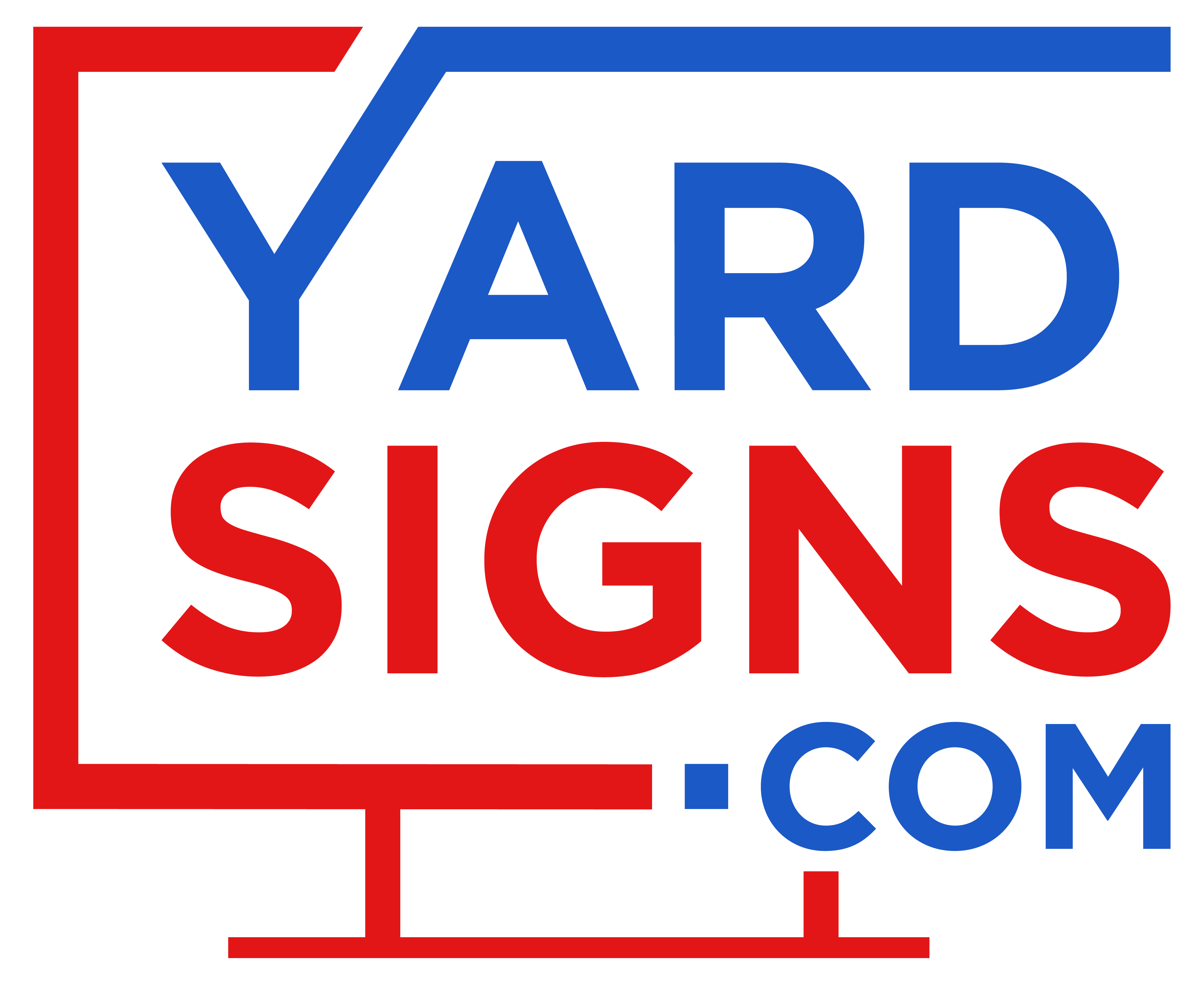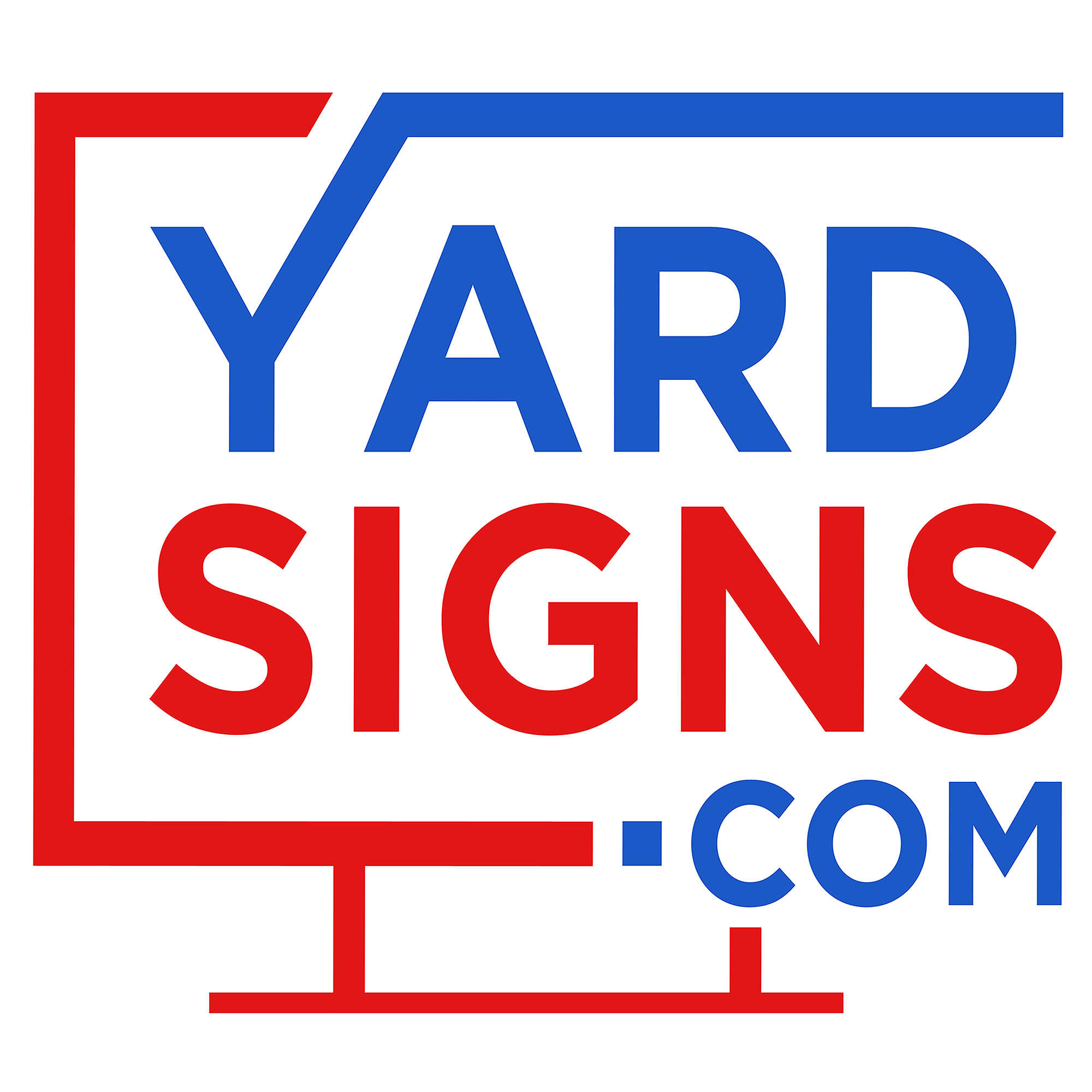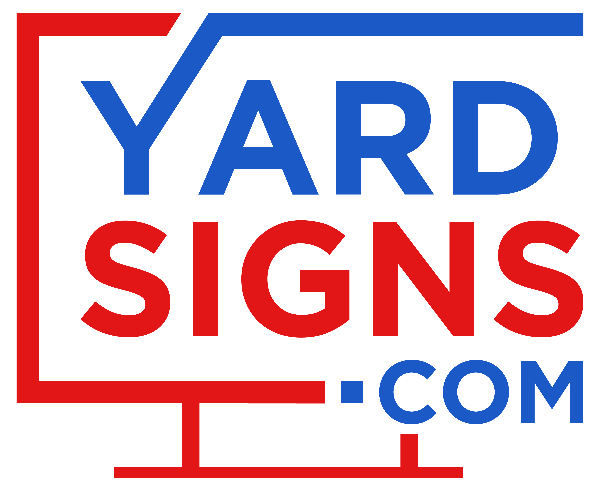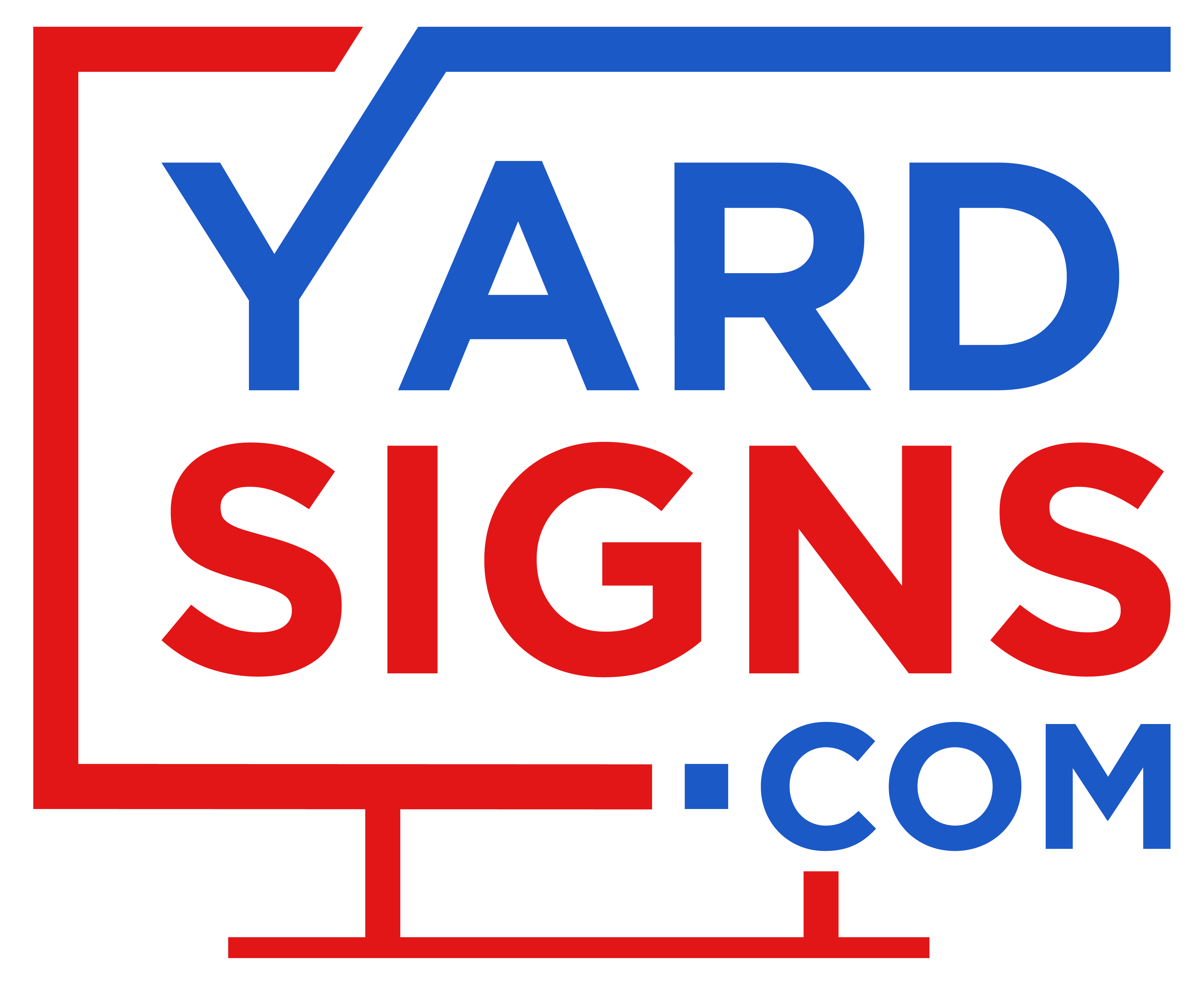Yard signs are a common way to share a message. People use them to promote local businesses, support political candidates, advertise events, or give directions.
However, placing a sign in the wrong location can lead to fines or removal. Laws that regulate where yard signs can go vary depending on the city, county, or state.
This guide explains where yard signs are legally allowed. It also covers what property owners, renters, and campaigners need to know before posting a sign.
Where Can You Legally Place Yard Signs?

The most straightforward answer to "where is it legal to put yard signs" is that they're generally legal on private property with the owner's permission. Public property typically has strict restrictions or outright prohibitions.
Legal placement locations for yard signs include:
- Your own yard (private property)
- Another person's private property (with permission)
- Designated community bulletin boards
- Commercial properties (with owner approval)
Regulations vary by location. A sign that's legal in one city might violate ordinances in another. Local zoning codes, municipal ordinances, and homeowners association rules all affect where signs can be placed.
Understanding Laws About Putting Up Signs
Different types of regulations govern yard sign placement. These include local ordinances, zoning rules, and right-of-way restrictions.
- Ordinance: A local law passed by a city or county that may limit sign size, duration, and placement.
- Zoning: Rules that divide land into different areas (residential, commercial, industrial) and determine what kinds of signs are allowed in each zone.
- Right-of-way: Land reserved for public use, like roads or sidewalks, where sign placement is often restricted.
1. Zoning Regulations
Zoning regulations control where and what type of signs can be placed. These rules vary based on how the land is classified.
For example:
- Residential zones typically limit signs to 4-6 square feet
- Commercial zones may allow larger signs (20+ square feet)
- Industrial zones might permit even larger signage
To find zoning regulations in your area, check your city or county website or contact the local planning department.
2. HOA And Neighborhood Rules
Homeowners Associations (HOAs) can enforce stricter sign rules than local governments through legally binding agreements called covenants, conditions, and restrictions (CC&Rs).
Key point: Even if a sign follows city rules, it may still violate HOA rules.
HOA restrictions might include:
- Limiting sign size to smaller dimensions than city ordinances
- Restricting certain types of signs entirely
- Requiring approval before posting any signs
- Setting specific time limits for temporary signs
Violating HOA rules can result in fines or required sign removal.
3. Local Ordinances On Sign Size And Duration
Most cities have specific rules about how big signs can be and how long they can stay up.
Common restrictions include:
- Maximum size: Often 4-6 square feet in residential areas
- Maximum height: Typically 3-4 feet above ground
- Time limits: Political signs might be allowed 30-90 days before an election and must be removed 7-10 days after
These rules apply equally to all signs regardless of content, as required by the Supreme Court's decision in Reed v. Town of Gilbert.
Can You Put Yard Signs Anywhere On Private Property?
While private property offers the most freedom for sign placement, homeowners don't have unlimited rights. Local laws and safety rules still apply to private property yard signs.
The First Amendment protects your right to express messages on your property, but this protection has limits. Cities can regulate non-communicative aspects of signs, such as:
- Size and height
- Distance from property lines
- Number of signs allowed
- Materials used
These regulations must be "content-neutral," meaning they apply equally to all signs regardless of what message they display.
1. Distance From Property Lines
Many areas require signs to be set back from property lines, streets, and sidewalks. These "setback requirements" help maintain visibility and prevent signs from extending into public spaces.
Common setback guidelines include:
|
Location |
Minimum Setback |
|
From sidewalk |
2–5 feet |
|
From street curb |
5–10 feet |
|
From neighbor's lot |
2–3 feet |
* Check your local zoning code for the specific requirements in your area.
2. Safety And Visibility Considerations
Signs must not create hazards or block visibility for drivers and pedestrians. This is especially important near intersections, driveways, and crosswalks.
Safety best practices include:
- Placing signs away from intersections where they might block views
- Keeping signs clear of traffic signs and signals
- Using materials that won't create hazards if blown over
- Ensuring signs don't block sidewalks or pedestrian paths
Is It Legal To Put Signs On Public Property?

Key point: It is generally illegal to put signs on public property without permission.
Public property includes parks, road medians, utility poles, sidewalks, and other government-owned spaces. Most cities prohibit placing private signs in these areas to maintain safety, accessibility, and visual appearance.
1. Public Right Of Way Rules
The public right of way includes roads, sidewalks, medians, and often a strip of land extending several feet from the edge of the street. This land is maintained for transportation and utility purposes.
Signs placed in the right of way can:
- Block visibility for drivers
- Interfere with pedestrian access
- Damage underground utilities during installation
- Create distractions that affect traffic safety
Examples of public right of way areas where signs are typically prohibited:
- Roadside medians
- Utility poles and traffic signals
- The strip of grass between sidewalk and street
- Highway shoulders and embankments
2. Potential Fines And Enforcement
Placing signs illegally on public property can result in consequences. Signs may be removed without notice, and fines may be issued to the person or organization responsible.
Typical penalties for first-time violations in selected cities:
|
City/County |
Fine per Violation |
|
Atlanta, GA |
$100–$500 |
|
Dallas, TX |
$200 |
|
Los Angeles, CA |
$250 |
* Some cities also charge for the cost of removing illegally placed signs.
Political Yard Signs Rules Georgia and Beyond
Political yard signs have special protections but also face specific regulations. These rules aim to balance free speech rights with community interests.
Key point: Most states protect political signs on private property but limit when they can be displayed.
In Georgia and many other states, political yard signs are subject to time restrictions. These limits typically relate to election dates rather than restricting the content of the message.
1. Campaign Sign Duration Limits
Most states and cities limit how long political signs can be displayed before and after elections:
- Georgia: 60 days before and 7 days after an election
- Texas: 90 days before and 10 days after
- California: 90 days before and 10 days after
These time frames help prevent permanent political displays while still allowing adequate time for campaign messaging.
2. Regulations On Language or Profanity
The First Amendment generally protects political speech, including messages that some might find offensive. Courts have consistently ruled that governments cannot restrict signs based on disagreement with the message.
However, two factors may limit profane or offensive language on signs:
- Local decency ordinances that apply to all public displays
- HOA rules that restrict offensive content through private contracts
While the government has limited power to restrict sign content, private entities like HOAs have more flexibility to enforce community standards.
Is it Illegal to Remove Political Signs in Georgia?
It is illegal to remove or tamper with political signs from private property in Georgia without the property owner's consent. This action may constitute theft, trespassing, or vandalism under state law.
Penalties for removing political signs can include fines, misdemeanor charges, or civil liability. The severity depends on factors like the value of the signs and whether the removal was a one-time incident or part of a pattern.
This protection applies to all political viewpoints. Removing signs because you disagree with the message is not legally justified, even if you find the content offensive.
Best Places To Put Yard Signs For Visibility
Strategic placement increases a sign's impact while staying within legal boundaries.
1. High Traffic Spots

The most effective legal locations for yard signs include:
- Near intersections on private property, where vehicles slow down
- Along busy streets (while respecting setback requirements)
- At driveway entrances, facing incoming and outgoing traffic
- On fences that face public areas (if the fence is on private property)
Remember that even high-visibility locations must comply with local regulations and property rights.
2. Angling And Height for Maximum Impact
How a sign is positioned affects how easily people can read it:
- Angle signs perpendicular to traffic flow so drivers can read them as they approach
- Place signs 2-3 feet above ground level to align with driver sight lines
- Keep signs clear of bushes, parked cars, or other visual obstructions
- For two-sided signs, ensure both sides face traffic coming from different directions
These placement techniques work within legal frameworks while maximizing visibility.
Is It Illegal to Put Up Yard Sale Signs?
Temporary yard sale signs follow different rules than permanent signs in many communities. While they're generally allowed, they must comply with specific regulations.
Key point: Yard sale signs are typically permitted as temporary signage but must follow local time and placement rules.
1. Common Time Restrictions
Most cities limit how long yard sale signs can be displayed:
- Signs may be placed 24-48 hours before the sale begins
- Signs must be removed within 24 hours after the sale ends
Some areas also restrict yard sales to certain days or times, which affects when signs can be displayed.
2. Best Practices for Compliance
To avoid problems with yard sale signs:
- Get permission before placing signs on private property you don't own
- Use easily removable materials that won't damage surfaces
- Remove all signs promptly after your sale ends
- Avoid utility poles, traffic signs, and public property
- Check if your city requires permits for yard sales or their signs
Next Steps for Confidently Displaying Your Yard Signs
Before placing yard signs, check both local sign ordinances and any HOA restrictions that apply to your property. Focus on rules about size, height, setbacks, and time limits.
Safety considerations are also important. Signs should never block visibility for drivers or pedestrians, especially near intersections or driveways.
Political signs follow similar general rules but may have specific timelines related to elections. In Georgia, for example, political signs are permitted 60 days before and 7 days after an election.
Remember that signs placed in public rights-of-way—such as on sidewalks, utility poles, or medians—may be removed without warning and could result in fines.
For custom, compliant yard signs that effectively communicate your message, visit Yardsigns.com.
Frequently Asked Questions About Legal Yard Sign Placement
Can you display profanity on your property?
The First Amendment generally protects profanity on private property signs, but local decency ordinances or HOA rules may impose restrictions that apply to all signage regardless of content.
Can I put yard signs anywhere for a charity event?
Temporary charity event signs must follow the same rules as other signs, though some communities offer special permits for non-profit events with specific time limits and placement guidelines.
What happens if I place signs in the public right of way?
Signs placed in public rights-of-way may be removed without notice, and you could face fines ranging from $50-$500 depending on your location and whether it's a repeat offense.
Do political signs have special protection?
Political signs on private property have First Amendment protections, but they still must comply with content-neutral regulations regarding size, height, and placement timing.
Can my landlord prevent me from putting up yard signs?
Landlords can restrict tenants from placing yard signs through lease agreements, as rental properties remain the landlord's private property even while occupied by tenants.




